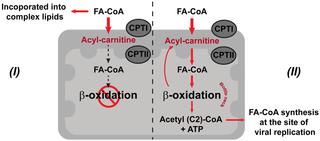PLoS Pathogens ( IF 5.5 ) Pub Date : 2018-02-15 , DOI: 10.1371/journal.ppat.1006853 Nunya Chotiwan 1 , Barbara G Andre 1 , Irma Sanchez-Vargas 1 , M Nurul Islam 1 , Jeffrey M Grabowski 2, 3 , Amber Hopf-Jannasch 4 , Erik Gough 5 , Ernesto Nakayasu 4 , Carol D Blair 1 , John T Belisle 1 , Catherine A Hill 3, 6 , Richard J Kuhn 2, 6 , Rushika Perera 1

|
We describe the first comprehensive analysis of the midgut metabolome of Aedes aegypti, the primary mosquito vector for arboviruses such as dengue, Zika, chikungunya and yellow fever viruses. Transmission of these viruses depends on their ability to infect, replicate and disseminate from several tissues in the mosquito vector. The metabolic environments within these tissues play crucial roles in these processes. Since these viruses are enveloped, viral replication, assembly and release occur on cellular membranes primed through the manipulation of host metabolism. Interference with this virus infection-induced metabolic environment is detrimental to viral replication in human and mosquito cell culture models. Here we present the first insight into the metabolic environment induced during arbovirus replication in Aedes aegypti. Using high-resolution mass spectrometry, we have analyzed the temporal metabolic perturbations that occur following dengue virus infection of the midgut tissue. This is the primary site of infection and replication, preceding systemic viral dissemination and transmission. We identified metabolites that exhibited a dynamic-profile across early-, mid- and late-infection time points. We observed a marked increase in the lipid content. An increase in glycerophospholipids, sphingolipids and fatty acyls was coincident with the kinetics of viral replication. Elevation of glycerolipid levels suggested a diversion of resources during infection from energy storage to synthetic pathways. Elevated levels of acyl-carnitines were observed, signaling disruptions in mitochondrial function and possible diversion of energy production. A central hub in the sphingolipid pathway that influenced dihydroceramide to ceramide ratios was identified as critical for the virus life cycle. This study also resulted in the first reconstruction of the sphingolipid pathway in Aedes aegypti. Given conservation in the replication mechanisms of several flaviviruses transmitted by this vector, our results highlight biochemical choke points that could be targeted to disrupt transmission of multiple pathogens by these mosquitoes.
中文翻译:

脂质的动态重塑与埃及伊蚊中肠中的登革热病毒复制相一致
我们描述了对埃及伊蚊中肠代谢组的首次全面分析,埃及伊蚊是登革热、寨卡病毒、基孔肯雅病毒和黄热病病毒等虫媒病毒的主要蚊子载体。这些病毒的传播取决于它们从蚊媒的多个组织感染、复制和传播的能力。这些组织内的代谢环境在这些过程中发挥着至关重要的作用。由于这些病毒有包膜,病毒的复制、组装和释放发生在通过操纵宿主代谢而启动的细胞膜上。干扰这种病毒感染诱导的代谢环境不利于人类和蚊子细胞培养模型中的病毒复制。在这里,我们首次深入了解埃及伊蚊虫媒病毒复制过程中诱导的代谢环境。使用高分辨率质谱,我们分析了登革热病毒感染中肠组织后发生的时间代谢扰动。这是感染和复制的主要部位,发生在系统性病毒传播和传播之前。我们确定了在感染早期、中期和晚期时间点表现出动态特征的代谢物。我们观察到脂质含量显着增加。甘油磷脂、鞘脂和脂肪酰的增加与病毒复制的动力学一致。甘油脂水平的升高表明感染期间资源从能量储存转移到合成途径。观察到酰基肉碱水平升高,表明线粒体功能受到破坏,并可能转移能量产生。 鞘脂途径中影响二氢神经酰胺与神经酰胺比率的中心枢纽被认为对病毒生命周期至关重要。这项研究还首次重建了埃及伊蚊的鞘脂通路。鉴于该载体传播的几种黄病毒复制机制的保守性,我们的结果强调了生化阻塞点,这些阻塞点可以有针对性地破坏这些蚊子多种病原体的传播。











































 京公网安备 11010802027423号
京公网安备 11010802027423号